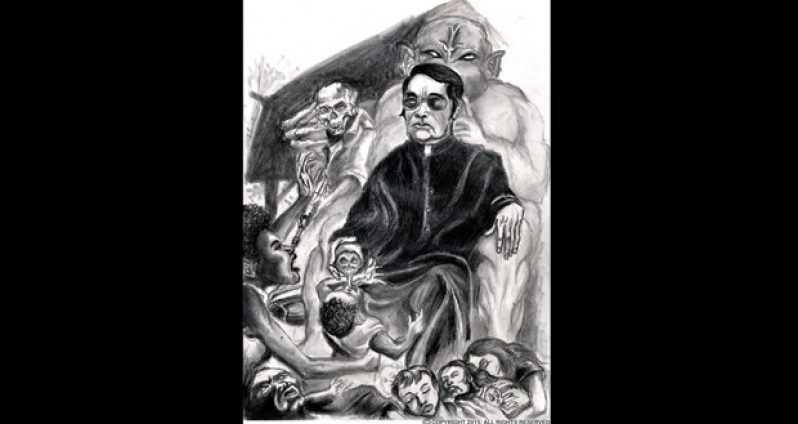Guilt is real, guilt is self imposed and guilt is fostered with fictions on the vulnerable consciousness to suit the agenda of others. Guilt can dominate us into false insecurities if its supposed root is not explored, only then to unearth substance or mirage. There is no reason that a political, social, historical or cultural guilt should exist in any area of the Guyanese ethos because of what happened there at Port Kaituma in 1979.
The nightmare of Jonestown was indeed a tremendous tragedy, but when the elements of what transpired there are explored outside of political chest beating (which, as my source of political enlightenment Tacuma once said to me “Politics hardly deals with what is true brother, it promotes what is believable”) as a consequence of political score padding, many Guyanese would have been led to interpret that the Government of the day had sat in a dark room with the Reverend Jim Jones and planned for a fee the murder of 900 people, creating a day of unforgettable infamy.
But put politics aside and explore the social elements that embodied the ‘People’s Temple’ and its believers, and what do we find? The mid 1970’s the civil rights and the flower [Hippy] movement had just passed. Pop-along on Durban Park was our mirror to that era, with its afterglow still cascading with imagery, music and “people philosophy” adding to our world view. The Black Panthers, Malcolm X, Franz Fanon where part of our conversations. Bob Marley had also added to the scene with his hymns of freedom. We collected Earth, Wind and Fire and Third World album covers and digested Swamp Dog. So against this cold war, racism in America backdrop comes Jim Jones and his wagons escaping the bad first world, how do Guyana say no to this cry for help, and still be revolutionary?
That the Reverend Jim Jones was Caucasian did not matter. By then we had read enough to know that there were White Americans who had been supporters of the values of change that enveloped the Civil rights movement, that many of them were beaten and murdered in that struggle and we also knew the story of John Brown, the planter who had freed his slaves and fought his slave owning neighbours. What Guyana could be accused of was naivety; the songs Sam Stone and Harry Hippy were just songs. Madness had no shades of grey to us, and only the functional “Saggywang” was homeless, unlike the 90’s to the present, where drug addicts roam our streets. In the 70s we had not yet lost our perspective innocence.
Jim Jones seemed like a great idea – a communist using religion to bring Americans through their own free will to build a community where Guyanese coastlanders were reluctant to venture. This settlement would serve as inspiration, especially if that community prospered and expanded, as the early Islander settlers did with hinterland landings some like Madhia.
Perhaps Jonestown would with time evolve into the idea of the kind of township touted after Independence – to build a new capital in this same North western region of Guyana, and the North West is beautiful.
The impetus rest with our speculations that can only be extracted from the post Independence thrust, when large bodies of coastal youth would for the first time witness the splendour and majesty of the hinterland through the Youth Corps, National Service and the Defence Force. One of the advantages of Jim Jones is that he had done or said nothing in the USA to raise red flags with the radical Afro-American community, so that there were no negative highlight warnings; he had played his game well to the time of arriving in Guyana.
What we now know is that Jim Jones was a “drug addict” whose altered mind demanded demi-godhood over his followers, sexual dominance, control of movement and their every utterance and extension of his thoughts. Adolf Hitler was also a “drug addict” who also had found a logical exploitable assembly of contentions among his people that enabled him to rise to become their Messiah, and enforce subtle fetters upon mind and body.
He had ordered his Nation to fight to the last German, to die also with dignity; children too were not spared. Then in 1997 Marshall Herff Applewhite convinced 38 normal people in California that suicide would free them from their horrible state enabling them to join the “Mothership” to immortality, all adorned in sneakers named after Nike, son of the Titan Pallas. And of course we can’t explore the phenomenon of Jim Jones without adding Charles Manson, whose name and exploits should be common to us all.
How do we define and embody “The People’s Temple” into our active consciousness? Simple. I can remember Debra Touchett [name spelt on sound] and a couple others who played B-Ball on the Parade ground. These people came to this country convinced they could make a new start; they came to be part of us from their own free will, our open mindedness and small faults were not a bother to them.
The old, the young with their babies – all would have been new Guyanese citizens. We owe them this recognition.
Jim Jones and his henchmen betrayed them, his colossal drug-abused ego destroyed their dreams, minds and bodies.
Let us consecrate a museum on that location; build a monument to honour the innocence that perished there. We owe them and ourselves that. Thus, I’m initiating the conversation.
BEYOND THE GHOSTS OF JONESTOWN
SHARE THIS ARTICLE :
Facebook
Twitter
WhatsApp




.png)









